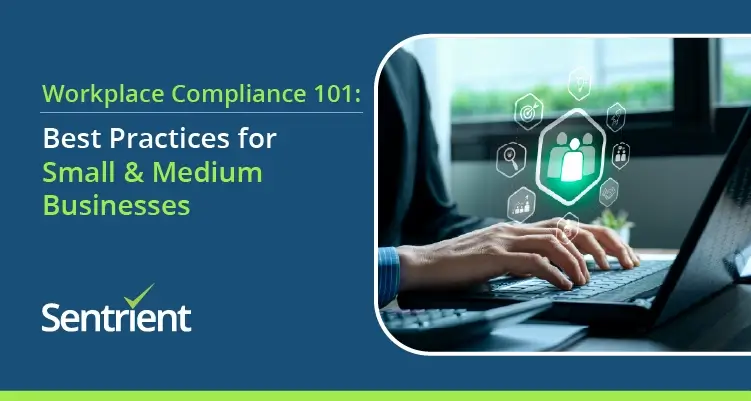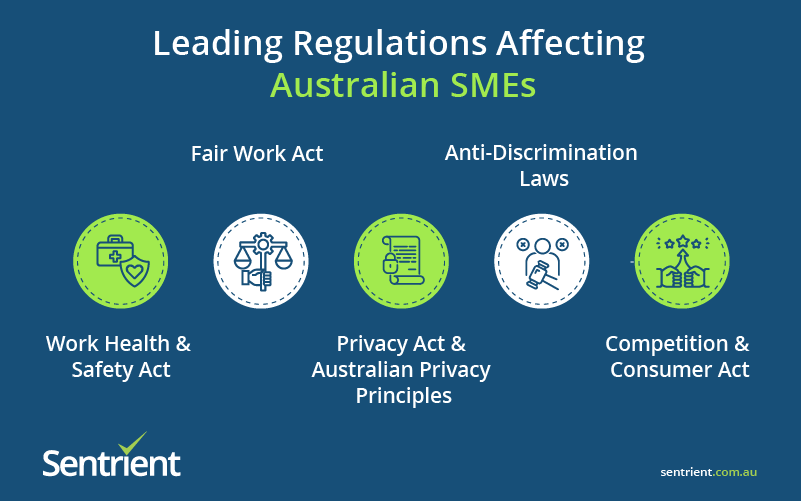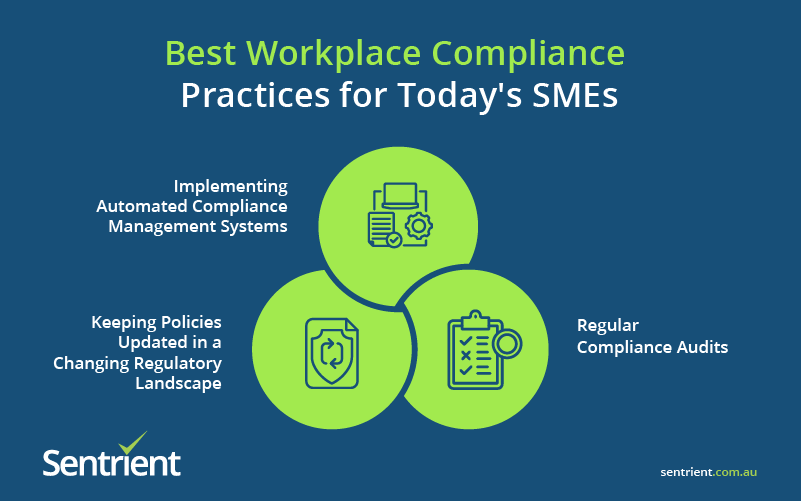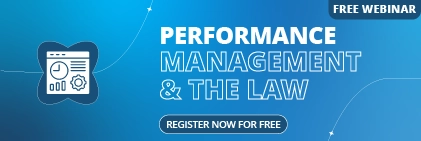Have you ever wondered what keeps your business legally sound and your employees safe? The answer is workplace compliance. For small and medium enterprises (SMEs), understanding and implementing proper compliance measures is good practice, essential for survival and growth in today’s business environment.
Workplace compliance refers to adhering to laws, regulations, standards, and ethical practices that apply to your business operations. For SMEs with limited resources, managing compliance can feel overwhelming, however there is help out there.
Today’s SMEs face unique compliance challenges, from keeping up with rapidly changing regulations to operating effective training programs without breaking the bank. Let’s explore how you can integrate workplace compliance without the headaches typically associated with it.
What is Workplace Compliance?
Workplace compliance is the process of ensuring your business adheres to all relevant laws, regulations, and standards that govern your operations. It’s about creating a safe, fair, and legally sound environment for everyone connected to your organisation.
At its core, compliance is about avoiding fines and building a foundation for ethical business practices that protect both your company and your people. For SMEs, compliance establishes trust with employees, customers, and partners.
Think of compliance as your business’s immune system, protecting it from legal vulnerabilities while strengthening its overall health and sustainability in a competitive marketplace.
What Does Workplace Compliance Cover?
Effective workplace compliance contains several critical areas that every SME owner should understand:
| Compliance Area | What It Covers | Why It Matters |
|---|---|---|
| Health & Safety | Workplace safety protocols, hazard management, emergency procedures | Prevents injuries, reduces liabilities, creates a secure working environment |
| Employment Law | Fair hiring practices, employment contracts, working hours, minimum wage | Prevents discrimination claims, ensures fair treatment of all staff |
| Data Protection | Customer and employee data security, privacy policies, breach procedures | Protects sensitive information, builds trust, avoids hefty penalties |
| Anti-discrimination | Equal opportunity policies, harassment prevention, inclusive practices | Creates a respectful workplace, prevents costly legal battles |
| Financial Compliance | Proper accounting, tax obligations, financial reporting | Maintains financial integrity, prevents fraud and audits |
Leading Regulations Affecting Australian SMEs
As an Australian business owner, you’ll need to navigate several significant regulatory frameworks:
- Work Health and Safety Act: Establishes duties for ensuring workplace health and safety. Note that specific WHS regulations may vary by state and territory.
- Fair Work Act: Governs employment relationships, minimum entitlements, and workplace rights. Recent changes include new provisions regarding casual employment and flexible working arrangements.
- Privacy Act and Australian Privacy Principles: Regulates how businesses collect, use, and disclose personal information. This primarily applies to businesses with an annual turnover of more than $3 million, though exceptions exist for healthcare providers, businesses that sell personal information, and certain other categories.
- Anti-Discrimination Laws: Including the Age Discrimination Act, Disability Discrimination Act, and Sex Discrimination Act.
- Competition and Consumer Act: Promotes fair trading and competition while protecting consumers.
Understanding these regulations is a fundamental aspect of running a legitimate business in Australia today.
Why Workplace Compliance Matters for Your Business
1. The Legal Consequences
The repercussions of non-compliance can be severe for SMEs. Legal penalties are not just inconvenient, they can be detrimental to companies without strong financial backing.
Australian regulatory bodies have the authority to issue substantial fines for breaches, with penalties sometimes reaching hundreds of thousands of dollars for serious violations. For SMEs, such financial blows can be devastating.
Beyond monetary penalties, non-compliance can lead to business disruption through enforced closures, mandatory training, or remediation periods that interrupt your normal operations.
2. The Financial Impact
The financial consequences of non-compliance extend far beyond government-imposed penalties:
- Legal costs: Defending against claims and implementing corrective measures can quickly drain resources.
- Increased insurance premiums: Non-compliant businesses face higher costs for liability and workers’ compensation coverage.
- Lost productivity: Time spent addressing compliance failures is time away from growing your business.
- Remediation expenses: Fixing compliance issues often requires investment in new equipment, training, or facilities.
For SMEs with limited capital reserves, these unexpected costs can trigger serious cash flow problems that threaten the entire business.
3. Damage to Reputation and Trust
In today’s connected world, compliance failures rarely stay confidential. When businesses fail to uphold proper standards, the reputational damage can outlast the legal consequences.
Customers increasingly factor ethical considerations into their purchasing decisions, with 83% of consumers preferring to buy from companies they trust (according to the 2023 Edelman Trust Barometer). One compliance scandal can undo years of brand building.
Employee trust is equally vulnerable. When staff witness compliance failures, they will lose confidence in leadership and become disengaged, leading to higher turnover and recruitment challenges.
The Ultimate Workplace Compliance Checklist for SMEs
1. Workplace Safety Compliance Fundamentals
Creating a safe workplace begins with understanding your obligations and implementing systematic safeguards:
- Conduct regular workplace risk assessments to identify potential hazards
- Develop and document safety procedures tailored to your specific industry
- Provide appropriate personal protective equipment (PPE) where needed
- Establish clear emergency protocols and evacuation procedures
- Maintain incident reporting systems to track and address safety concerns
Remember that workplace safety is an ongoing commitment, requiring regular review and adjustment as your business evolves.
2. Policy Development and Implementation
Effective policies form the backbone of your compliance program, communicating expectations and procedures clearly to all stakeholders:
- Create comprehensive workplace policies covering conduct, safety, discrimination, harassment, and privacy
- Ensure policies are accessible to all employees through multiple channels
- Review and update policies regularly to reflect changing regulations
- Document policy acknowledgements from all staff members
- Establish reporting mechanisms for policy violations
The best policies balance legal protection with practical guidance, helping employees understand not just what to do, but why it matters.
3. Record Keeping and Documentation
Detailed documentation serves as an insurance policy for your business. Proper record keeping reinforces your compliance efforts and provides crucial evidence if disputes arise.
Essential records for SMEs include:
- Employee training completion certificates
- Workplace inspection reports
- Incident investigations and outcomes
- Policy acknowledgements
- Equipment maintenance logs
- Risk assessment documentation
Establish a systematic approach to record keeping, whether through dedicated software or well organised physical files, ensuring retrieval is straightforward when needed.
HR Compliance Guideline for Your SME’s Success
Human resources compliance touches nearly every aspect of your business operations. From the moment you advertise a position to an employee’s final day, HR practices must align with legal requirements.
For SMEs without dedicated HR departments, compliance responsibilities often fall to owners or managers with limited expertise. This makes establishing clear, compliant systems even more critical.
Getting HR compliance right creates a fair, transparent workplace where employees understand their rights and responsibilities, reducing conflicts and legal exposure.
Common HR Compliance Mistakes SMEs Make
SMEs frequently encounter these HR compliance pitfalls:
- Misclassifying employees as independent contractors
- Failing to maintain accurate time records for hourly workers
- Inconsistent application of workplace policies across different employees
- Inadequate privacy protections for employee personal information
- Overlooking required workplace posters and notifications
- Conducting improper or inadequate workplace investigations
Recognising these common mistakes allows you to proactively address potential vulnerabilities before they escalate into serious problems.
How to Create Compliant HR Processes?
Develop systematic approaches to key HR functions:
| HR Process | Compliance Considerations |
|---|---|
| Recruitmen | Non-discriminatory job descriptions, consistent interview questions, proper background check procedures |
| Onboarding | Required tax forms, superannuation choices, policy acknowledgements, employment contracts |
| Performance Management | Objective criteria, consistent documentation, fair evaluation processes |
| Discipline | Progressive discipline policies, thorough documentation, consistent application |
| Termination | Final pay calculations, return of company property, appropriate separation documentation |
Using digital HR systems like Sentrient’s HR Management System can help standardise these processes, reducing the risk of compliance oversights.
Role of Employee Training in Compliance Culture
Even the most comprehensive policies are ineffective if employees don’t understand or follow them. Training bridges the gap between written rules and actual workplace behaviour.
Effective compliance training reduces risk by ensuring employees recognise potential issues, understand their responsibilities, and know how to respond appropriately in challenging situations.
For SMEs, investing in quality training delivers returns through fewer incidents, reduced liability, and a more engaged workforce committed to maintaining a safe, ethical workplace.
Industry-Specific Compliance Considerations
Some sectors face particularly intensive regulatory scrutiny:
| Industry | Key Compliance Areas | Special Considerations |
|---|---|---|
| Healthcare | Patient privacy, clinical standards, medication management | Regular updates to medical protocols, strict documentation requirements |
| Financial Services | Anti-money laundering, responsible lending, financial advice standards | Extensive reporting obligations, mandatory disclosure requirements |
| Construction | Worker safety, building codes, environmental regulations | Site-specific compliance plans, contractor management requirements |
| Food Service | Food safety, hygiene standards, allergen management | Regular inspections, certification requirements, temperature monitoring |
| Childcare | Working with children checks, facility safety, staff qualifications | Heightened background screening, strict staff-to-child ratios |
Businesses in these sectors often benefit from industry-specific compliance modules, like those available through Sentrient’s platform. For example, healthcare providers can access modules specifically designed for patient privacy and clinical standards compliance, while construction businesses can use templates for site safety plans that meet industry regulations.
How to Define Your Compliance Approach for Your Business?
Even within industries, compliance needs vary based on:
- Business size: Smaller organisations may qualify for different requirements
- Geographic location: State-specific regulations may apply
- Operational model: Different rules for different business structures
- Workforce composition: Special provisions for diverse employee populations
- Risk profile: Some activities carry inherently higher compliance requirements
The most effective compliance programs are tailored to your specific business context, taking into account your unique operational needs, workforce composition, and industry requirements. A one-size-fits-all approach rarely provides adequate protection.
Common Compliance Mistakes and How to Avoid Them
1. Overlooking Policy Updates
One of the most common compliance failings is allowing policies to become outdated. Regulations change continually, and policies must evolve accordingly.
Set calendar reminders for regular policy reviews – at minimum annually, but more frequently for rapidly changing areas like data security or employment law.
Consider subscribing to regulatory update services or industry newsletters that provide early notification of upcoming changes affecting your business.
2. Documentation Gaps
“If it isn’t documented, it didn’t happen” is a harsh reality in compliance matters. Common documentation oversights include:
- Failing to record verbal warnings in disciplinary situations
- Incomplete safety inspection records
- Missing signatures on policy acknowledgements
- Inadequate incident investigation documentation
- Inconsistent training records
Implement systematic documentation procedures for all compliance-related activities, using standardised forms or digital platforms to ensure consistency.
3. Training Without Verification
Many businesses conduct training but fail to verify that employees genuinely understand the material. This creates a dangerous compliance illusion.
Incorporate knowledge checks into all compliance training, whether through quizzes, scenario discussions, or practical demonstrations of required skills.
Follow-up training with observations of actual workplace behaviour to ensure classroom learning translates to compliant practices on the job.
Best Workplace Compliance Practices for Today’s SMEs
1. Regular Compliance Audits
Proactive compliance monitoring helps identify potential issues before they become serious problems. Regular audits should examine:
- Policy adherence across departments
- Training completion rates and effectiveness
- Incident reporting patterns and resolution
- Documentation completeness and accuracy
- Employee understanding of compliance responsibilities
Consider scheduling comprehensive compliance reviews annually, with more frequent spot-checks of high-risk areas like safety equipment or data security practices.
2. Keeping Policies Updated in a Changing Regulatory Landscape
Regulations evolve constantly, making policy maintenance an ongoing necessity. Establish systematic review processes:
- Assign ownership for monitoring regulatory changes in your industry
- Schedule regular policy reviews (at least annually)
- Document all policy updates with version control
- Communicate changes clearly to all affected employees
- Provide supplemental training when significant changes occur
Remember that outdated policies can be worse than no policies at all, creating a false sense of compliance while leaving your business vulnerable.
3. Implementing Automated Compliance Management Systems
Technology dramatically simplifies compliance management for resource constrained SMEs:
- Centralised documentation ensures the latest versions are always accessible
- Automated reminders reduce the risk of missed deadlines or requirements
- Streamlined reporting generates audit-ready documentation quickly
- Integration capabilities connect compliance with other business systems
- Analytics tools identify patterns and potential problem areas
Sentrient’s Compliance Management System offers these capabilities in a platform designed specifically for Australian SMEs, reducing administrative burden while strengthening compliance outcomes.
How Compliance Software Transforms SME Risk Management
Modern compliance software changes the equation for small businesses, making comprehensive compliance management achievable without dedicated compliance departments:
- Centralisation: All compliance activities managed from a single platform
- Automation: Scheduled reminders, escalations, and reports without manual intervention
- Visibility: Real-time dashboards showing compliance status across the organisation
- Standardisation: Consistent processes regardless of who handles compliance tasks
- Evidence: Automatic documentation of compliance activities for audit purposes
With proper compliance software, SMEs can achieve enterprise-level compliance capabilities without enterprise-level resources.
Benefits of Online Compliance Training Solutions
Digital training platforms offer particular advantages for resource-constrained businesses:
- Reduced administrative burden through automated assignment and tracking
- Consistent delivery of accurate, up-to-date compliance information
- Flexible scheduling that minimises operational disruption
- Comprehensive reporting for regulatory requirements
- Multi-device accessibility, enabling completion anywhere
- Cost-effective implementation compared to in-person training
When evaluating online training solutions, look for platforms offering Australian-specific content that addresses your industry’s particular compliance requirements.
How Sentrient’s Compliance Management System Helps SMEs
Sentrient’s platform is specifically designed to address the unique compliance challenges facing Australian small and medium businesses:
- Integrated approach combining training, policy management, and documentation
- Australian focused content reflecting local regulatory requirements
- User-friendly interface requiring minimal technical expertise
- Scalable platform growing with your business needs
- Cloud-based accessibility, enabling management from anywhere
- Automated reminders ensuring nothing falls through the cracks
By consolidating compliance activities into a single system, Sentrient helps SMEs achieve comprehensive compliance with minimal administrative overhead.
Why Sentrient is Your Ideal Compliance Partner?
Sentrient’s compliance solutions are specifically designed for Australian business requirements, with content aligned to local legislation and training reflecting Australian workplace norms. Their templates are customised for Australian business operations, with support from experts familiar with our unique compliance landscape.
Sentrient offers a holistic approach to compliance through integrated online training, policy management, and records management in one seamless platform. The system includes incident tracking capabilities and risk management functionality that work together to create a complete compliance ecosystem.
Conclusion
Compliance success is an ongoing journey that requires regular attention as regulations evolve. Start by assessing your current status, identifying gaps, and creating a phased implementation plan that addresses your highest-risk areas first, ensuring manageable progress without overwhelming your resources.
When you combine clear policies, consistent training, and proper documentation, compliance transforms from burden to competitive advantage, improving your reputation and reducing operational risks.
Sentrient’s all-in-one Compliance Management System automates the most challenging aspects of compliance, from policy distribution to training tracking, making comprehensive compliance achievable for businesses of any size.
Contact Sentrient today for a free demonstration of our Australian-focused compliance solutions designed specifically for small and medium businesses.
FAQs:
1. What are the key workplace compliance laws small businesses must follow?
Small businesses in Australia must comply with the Work Health and Safety Act, Fair Work Act, Privacy Act, and anti-discrimination laws. Requirements vary by industry, with sectors like healthcare and construction facing additional regulations. Sentrient helps identify and address your specific obligations through tailored compliance solutions.
2. How can SMEs ensure compliance with workplace safety regulations?
Start with risk assessments to identify hazards in your workplace. Develop clear safety policies, provide appropriate training, and maintain incident records. Regular safety audits help prevent incidents before they occur. Sentrient offers tools for policy management, incident tracking, and safety training to simplify this process.
3. What are the consequences of non-compliance for small and medium businesses?
Beyond potential fines, consequences include legal expenses, business interruption, increased insurance premiums, and damage to your reputation. In serious cases, directors may face personal liability. The most significant impact is often on customer trust and employee relationships, which can affect your business long-term.
4. How regularly should businesses update their workplace policies to stay compliant?
Review policies at least annually, with more frequent updates for rapidly changing areas like data security. Always update policies after significant regulatory changes, workplace incidents, or operational modifications. Sentrient’s tools automate policy review reminders and ensure all employees access current versions.
5. What is the best way to train employees on workplace compliance?
Use scenario-based training relevant to employees’ actual roles rather than generic information. Online training offers consistency, scheduling flexibility, and comprehensive tracking. Regular refreshers and practical application are essential. Sentrient provides engaging, industry-specific compliance training for Australian workplaces.
6. How can AI help SMEs manage compliance effectively?
AI helps identify potential risks before incidents occur, reviews policies for gaps, and monitors compliance activities automatically. For small businesses, AI tools offer efficiency through automation of routine tasks like training assignments and deadline management. These technologies make enterprise-level compliance capabilities accessible to SMEs with limited resources, providing sophisticated monitoring and analytics that would otherwise require dedicated compliance staff.
7. What industries have the most stringent workplace compliance requirements?
Healthcare, financial services, food production, childcare, and construction face the most intensive regulation. Requirements vary based on business size, activities, and location. Sentrient offers industry-specific compliance solutions that incorporate sector requirements into training, policies, and risk management tools.








